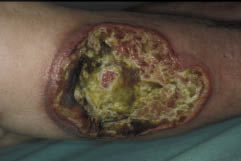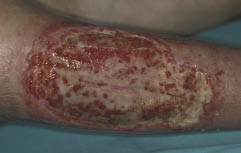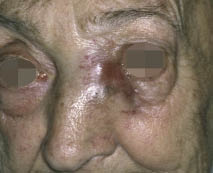Anke Süß1, Jan C. Simon1 and Michael Sticherling2
1Department of Dermatology, University of Leipzig, Phillip-Rosenthal-Str. 23–25, DE-04103 Leipzig, and 2Department of Dermatology, University Hospital of Erlangen, Erlangen, Germany. E-mail: anke.suess@medizin.uni-leipzig.de
Accepted October 12, 2006.
Sir,
Primary cutaneous diffuse large B-cell lymphoma, leg type (PCLBCL, leg type) is a distinct clinicopathological entity found predominantly in elderly females. Compared with primary cutaneous lymphomas of other skin locations, it exhibits a more aggressive behaviour and poorer outcome and it is therefore regarded as a unique entity (1). Reports on PCLBCL, leg type, arising on sites other than the leg are limited. We report here on a patient with PCLBCL, leg type, with the clinical picture of chronic venous ulceration and a subsequent manifestation in the face, which showed an excellent response to local radiotherapy.
CASE REPORT
An 83-year-old woman presented with a 3-year history of ulceration on her right lower leg. In the past she had been treated for venous stasis ulceration with different external therapies. Despite this treatment the ulceration had progressed continuously. Her medical history included chronic congestive heart failure, aortal stenosis and diabetes mellitus type II. The patient did not report any constitutional symptoms, such as fever, night sweats or weight loss.
The patient presented in reduced physical condition with lymphoedema and a brownish hyperpigmentation of both lower legs. The foetid ulcer on the lateral proximal aspect of her right lower leg measured 8×12 cm and showed elevated tumorous borders (Fig. 1).

Fig. 1. Large ulceration with tumorous borders on the lateral aspect of the left lower leg.
Biopsies of the ulcer revealed a dense infiltrate in addition to small pleomorphic lymphocytes, dominated by large blastoid cells, that could not be definitely classified. Approximately half of the infiltrating cells stained positive for CD20, confirming their B-cell phenotype. Bcl-2 was highly expressed by atypical cells. This is typically found in PCLBCL, leg type, but is absent in other entities of primary cutaneous B-cell lymphomas (2). In molecular clonality analysis, no clonal rearrangement of the T-cell-receptor gene was found. There was also no clonal rearrangement of the immunoglobulin heavy chain locus (IgH), which serves as a proof of monoclonal B-cell expansion in the diagnosis of B-cell lymphomas. However, this rearrangement is often not detectable in B-cell lymphomas as the number of malignant B-cells may be too low to be detected by polymerase chain reaction (PCR) methods (3).
In magnetic resonance tomography scans of the right lower leg, the tumour was found to infiltrate muscles and muscle fascia of the lower leg. In computed tomography scans of the thorax and abdomen and ultrasound lymph node examination, no extracutaneous lymphomas were found. In fluorescent activated cell sorter analysis of peripheral blood, no circulating lymphoma cells were detectable.
Based on these findings, the diagnosis of PCLBCL, leg type, was made. However, since the patient refused a bone marrow biopsy, a secondary cutaneous B-cell lymphoma could not be ruled out completely.
Borrelia burgdorferi serology was positive (Lyme Rec Blot IgM V1sE+, Rec Blot IgG V1sE+, OspC+, Osp17+++), but PCR of tumour tissue for Borrelia antigen OspA was negative. Antibiotic treatment with Ceftriaxon 2 mg/day for 14 days was without clinical response. Consequently local 8 and 13 MeV electron radiotherapy with a total dose of 40 Gy was performed, which resulted in clinical remission of the ulcer’s tumorous borders. Punch biopsy of the ulcer’s border after radiotherapy showed fibrosis without evidence of remaining lymphoma. Following intensive local therapy with alginate and hydrocolloid wound dressings, a clean, granulating ulceration was induced (Fig. 2). Six months after primary diagnosis, a rapidly growing, livid tumour 7×5 cm in size in the left inner corner of the eye, impairing the patient’s vison, was noticed (Fig. 3). The lesion had been interpreted as a haematoma by the patient. Biopsy of the facial tumour, however, revealed histological findings identical to the leg tumour and thus a manifestation of the patient’s lymphoma was diagnosed. Local 6 MeV electron radiotherapy with a total dose of 40 Gy was performed with complete clinical remission. As the patient refused chemotherapy, she attended regular controls in our outpatient clinic for 16 months after primary diagnosis, which showed gradual reduction in ulcer size and no evidence for further manifestations or relapse of the lymphoma.

Fig. 2. Clean and granulating leg ulcer 3 months after radiotherapy.
Fig. 3. Rapidly growing tumour on the patient’s left nose angle 6 months after radiotherapy on the leg ulcer.

DISCUSSION
After years of considerable debate, PCLBCL, leg type, is now recognized as a separate entity by the WHO European Organisation for Research and Treatment of Cancer (EORTC) consensus classification for primary cutaneous lymphomas (1). PCLBCL, leg type, is characterized by rapidly growing tumour masses of the lower leg with a poor prognosis, i.e. a 5-year survival rate of only 58% due to frequent spread of the disease to lymph nodes and internal organs (4).
Recently, several authors have reported on the efficacy of systemic antibiotic therapy, achieving complete remission in some cases with primary cutaneous B-cell lymphoma (CBCL) and positive anti-Borrelia burgdorferi-antibody titres (5). This type of treatment is conceptually analogous to that adopted for Helicobacter pylori-associated mucosa-associated lymphoid tissue lymphomas of the stomach, which in the early stages can be cured by eradication of H. pylori infection (6). It has been proposed that CBCL may arise from chronically stimulated skin lymphoid tissue in response to B. burgdorferi infection (7). In our case, antibiotic treatment did not result in a clinical response, although anti-B. burgdorferi- IgM antibody titres were detected. This could be due to the long course of the disease over more than 3 years, during which B. burgdorferi as the initial factor may have lost its relevance. Moreover, in endemic areas a positive Borrelia serology may not be sufficient evidence for a correlation of infection and lymphoma.
The first choice of treatment for PCLBCL, leg type, is anthracycline-based chemotherapy (1), but this was refused by our patient. In patients presenting with small solitary lesions electron or photon beam radiotherapy is an effective alternative (8, 9). In our patient, local radiotherapy led to a complete clinical remission. A second cutaneous manifestation in the face 6 months after radiotherapy of the initial lesion on the lower leg also achieved a complete clinical remission after radiotherapy. Surgical excision of the tumours may be considered in certain cases, but this was not an option in our case.
In relapsing and generalized PCLBCL, leg type, polychemotherapy is recommended. Recently, it has been demonstrated that the anti-CD20 monoclonal antibody rituximab is an effective treatment for patients with PCLBCL, leg type (6). Due to the age of the patient, as well as potential side-effects, anti-CD20 treatment was not initiated and, furthermore, was refused by the patient.
This case report emphasizes the importance of differential diagnosis in long-standing ulcers of the leg that do not respond to adequate therapy or which exhibit unusual clinical features (10). Furthermore, it emphasizes the efficacy of radiotherapy in the treatment of PCLBCL, leg type, which is well tolerated even in multi-morbid patients.
REFERENCES
1. Willemze R, Jaffe ES, Burg G, Cerroni L, Berti E, Swerdlow SH, et al. WHO-EORTC classification for primary cutaneous lymphomas. Blood 2005; 105: 3768–3785.
2. Flaig MJ, Sander A. Diagnostik kutaner B-Zell-Lymphome. Pathologe 2000; 21: 190–196.
3. Sander CA, Kaudewitz P, Kutzner H, Simon M, Schirren CG, Sioutos N, et al. T-cell rich B-cell lymphoma presenting in skin. J Cutan Pathol 1996; 23: 101–108.
4. Querfeld C, Guitart J, Kunzel TM, Rosen ST. Primary cutaneous lymphomas: a review with current treatment options. Blood Rev 2003; 17: 131–142.
5. Hofbauer GFL, Kessler B, Kempf W, Nestle FO, Burg G, Dummer R. Multilesional primary cutaneous diffuse large B-cell lymphoma responsive to antibiotic treatment. Dermatology 2001; 203: 167–168.
6. Kerl H, Cerroni L, Fink-Puches R, Wolf IH. Primary cutaneous B-cell lymphomas. J Dtsch Dermatol Ges 2004; 7: 605–620.
7. Slater DN. Borrelia burgdorferi-associated primary cutaneous B-cell lymphoma. Histopathology 2001; 38: 73–77.
8. Eich HT, Eich D, Micke O, Suttzer T, Casper C, Krieg T, Muller RP. Long-term efficacy, curative potential, and prognostic factors of radiotherapy in primary cutaneous B-cell lymphoma. Int J Radiat Oncol Biol Phys 2003; 4: 899–906.
9. Smith BD, Smith GL, Heald PW, Cooper D, Wilson LD. Effectiveness of radiotherapy as initial treatment for cutaneous B-cell lymphoma. Int J Radiat Oncol Biol Phys 2003; 57: 290.
10. Garbea A, Dippel E, Hildenbrandt R, Bleyl U, Schadendorf D, Goerdt S. Cutaneous large B-cell lymphoma of the leg masquerading as a chronic venous ulcer. Br J Dermatol 2002; 146: 144–147.
